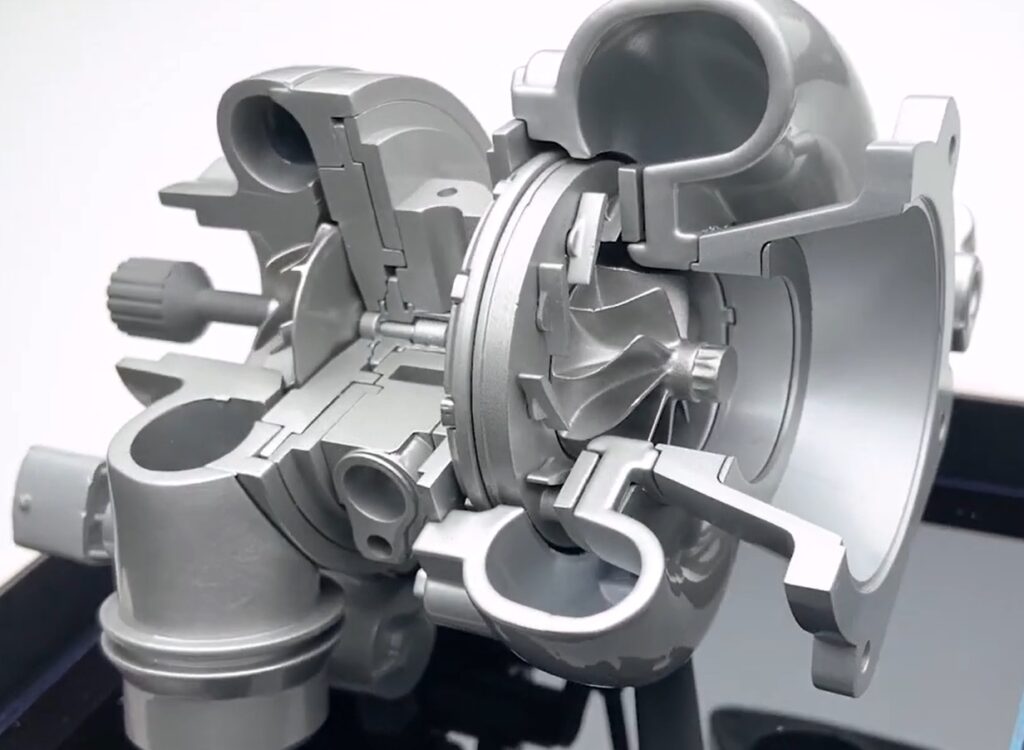Do you have an issue with your turbocharger? This page will give you a better understanding in order to narrow down the issue!
What is a turbocharger?
In general, it can be said that the engine performance of a motor depends on the air volume/air mass drawn in. The more air is available, the higher the engine power can be. In order to increase engine output while maintaining the same displacement, an exhaust gas turbocharger is usually used.
A turbo, also called exhaust gas turbocharger, is a component of a turbocharged engine which has the task of compressing the intake air. Compressing the air results in significantly better filling of the cylinders compared to normal naturally aspirated engines. Due to the increased density of the intake air, it is possible to feed a higher quantity of oxygen into the engine’s combustion chamber. The turbo principle has two advantages. On the one hand, a higher engine output can be achieved and, on the other, lower fuel consumption. The lower fuel consumption also ensures that the engine is more efficient and environmentally friendly.
What does a turbocharger do?
The exhaust gas turbocharger consists of a turbine wheel (exhaust side) and a compressor wheel (intake side). The two wheels, also known as paddle wheels, are firmly connected via a shaft.
The turbine wheel (exhaust side) is always driven by the exhaust gases resulting from the combustion of the engine. The exhaust gases are glided at high speed via the exhaust manifold to the exhaust housing of the turbo. The turbine wheel is located in the exhaust housing.
As soon as the turbine wheel is driven by the exhaust gases, the compressor wheel also turns, since they are rigidly connected to each other. Ambient air is drawn in by the rotary motion of the compressor wheel. After the intake air has been compressed by the turbo, the air flows on to the intercooler. This is because the compression of the intake air causes the air to heat up very strongly. The intercooler is used to cool the air. The air then flows onto the intake manifold and can now be drawn in by the engine via the intake valves to the combustion chamber.
Special geometry of a VTG turbocharger
Today’s vehicles with diesel engines normally always use a turbocharger using VTG (Variable Turbine Geometry). The VTG-turbo is characterized by adjustable guide vanes on the turbine wheel (on the exhaust side).

The advantage here is that at low speeds, the adjustable guide vane is adjusted in such a way that the flow cross-section of the turbine wheel is reduced. This allows the turbocharger to build up boost pressure even at low speeds.
The more the engine speed increases, the more the guide vanes open in order not to exceed the maximum boost pressure stored in the control unit. Another advantage of the VTG-turbo is that there is no need for a bypass valve for boost pressure control.
Components of the turbo-system
Intercooler
As already mentioned, the intercooler has the function of cooling the intake air. This is because the compression process of the intake air in the turbocharger causes it to heat up very strongly.
Intercoolers are normally using the principle of heat exchangers. As a rule, intercoolers are ‘air-to-air coolers’. This means that the charge air is cooled by the airstream. For this reason, the intercooler is usually located in front of the radiator in front of the vehicle.
However, water-cooled charge air coolers are also available for newer vehicles. The water intercooler has its own cooling water circuit, also known as a low-temperature circuit. Here, the cooling water is in turn cooled by the airstream via its own cooling water cooler in the front of the vehicle.
Charge air piping
Charge air piping is necessary to convey the intake air to the turbocharger and to guide the compressed air from the intake tract. These rubber hoses or metal pipes connect all components of the turbo system that need the air supply.
Recirculating thrust air valve
Recirculation valves are installed in all series-produced turbo vehicles, but only in vehicles with gasoline engines. The divert-air valve is often colloquially referred to as the ‘blow-off valve’.
The task of the divert-air valve is to divert excess boost pressure back into the intake tract to enable the turbocharger to respond more quickly.
As soon as the driver of the vehicle releases the accelerator pedal, the throttle valve also closes at the same moment and the divert-air valve opens. The divert-air valve can be controlled electrically or via vacuum.
If no divert-air valve were installed, the remaining charge air would back up in front of the throttle valve, reverse and hit the compressor wheel of the turbo again. This results in the compressor wheel being braked, which means that the boost pressure has to be built up again. On the other hand, this can also lead to long-term damage to the turbo.
Boost pressure control
For an optimal function of the combustion engine, the boost pressure must always correspond to the set point value in the engine control unit. The boost pressure value is predefined in the engine control unit for various engine speeds and load conditions.
The simplest and most common form of boost pressure control is implemented via a bypass damper. The bypass flap is installed in the exhaust housing of the turbocharger. As soon as the defined boost pressure value is reached, the bypass flap opens, causing some of the exhaust gases to flow past the turbine wheel. This reduces the speed of the turbine wheel and no more boost pressure is built up.
As already mentioned above, boost pressure control in diesel vehicles is controlled via the VTG turbo.
Diagnosis and repair of faults on the turbocharger
If you suspect any issue, we recommend running a diagnosis using an OBD2 adapter, first. This will read your error memory from your ECUs. In many cases you can find out when an error (DTC) has been detected and what specifically the error is.
OBD adapters and diagnostic equipment can be used to diagnose a variety of engine problems, regardless of make or model. The issues found vary between simple sensor defects and more complex problems, such as turbocharger defects. In some specific cases, an OBD adapter can help fixing an issue. Sometimes just clearing old trouble codes (DTCs) will help, saving you a trip to the repair shop.
Whether you like fixing stuff yourself or you are a professional, a diagnostic device is a valuable tool that every driver should have in his car.
Cost of repair on the turbocharger system
The estimation of the cost for a repair on the turbocharger is very difficult, because the cost range may differ extremely related to the cause of the issue. This issue may be related to a cheap defective vacuum hose or the turbo itself.
The costs can range from US$ 15 to US$ 2000. Therefore, troubleshooting should be carried out very carefully in order to actually find the error.
To keep the costs of a defective turbocharger low, a turbo can also be overhauled.
This means that the turbo is disassembled into its individual parts in order to check exactly what is defective on the turbo itself. After troubleshooting, the defective parts on the turbo are replaced.


